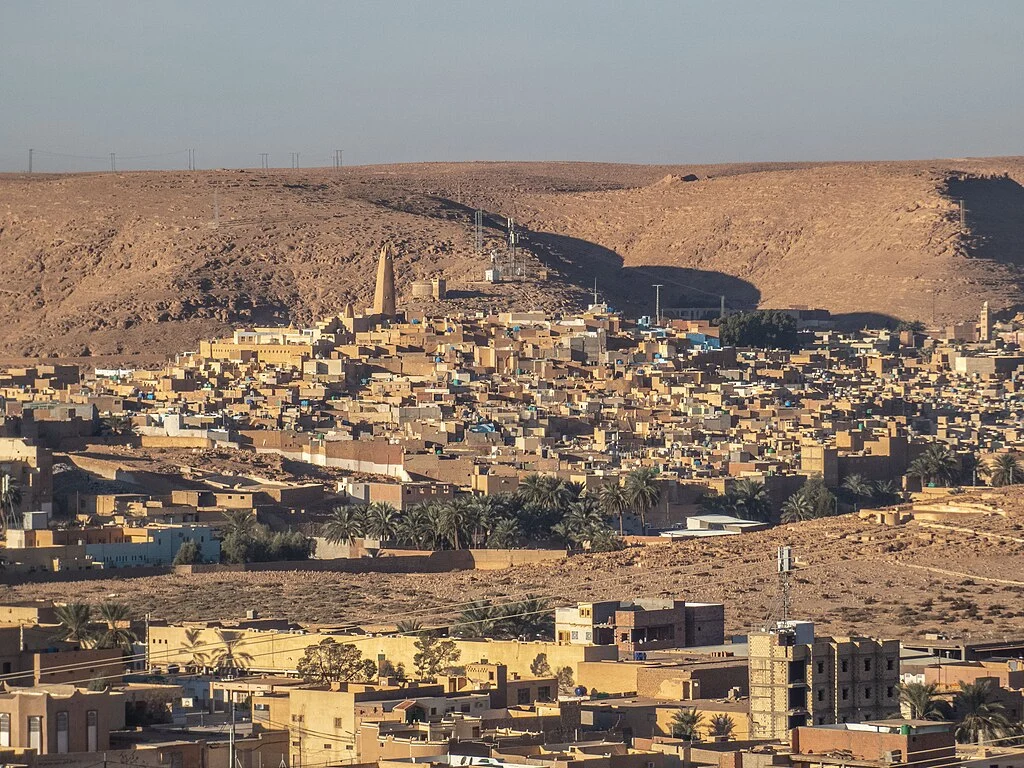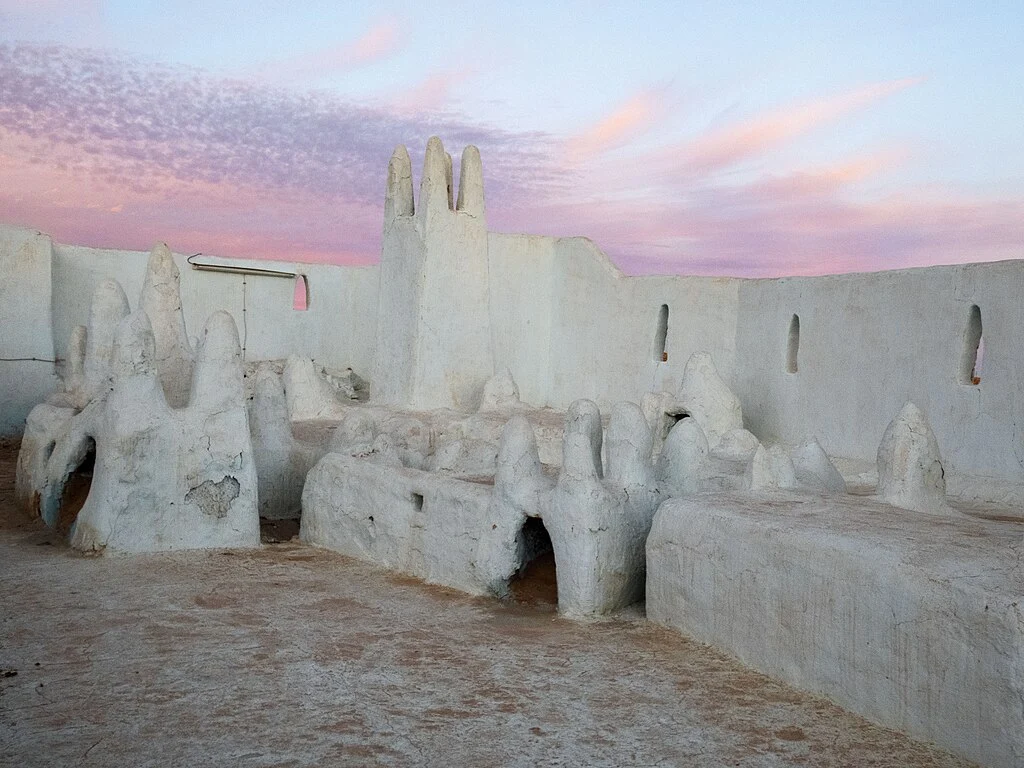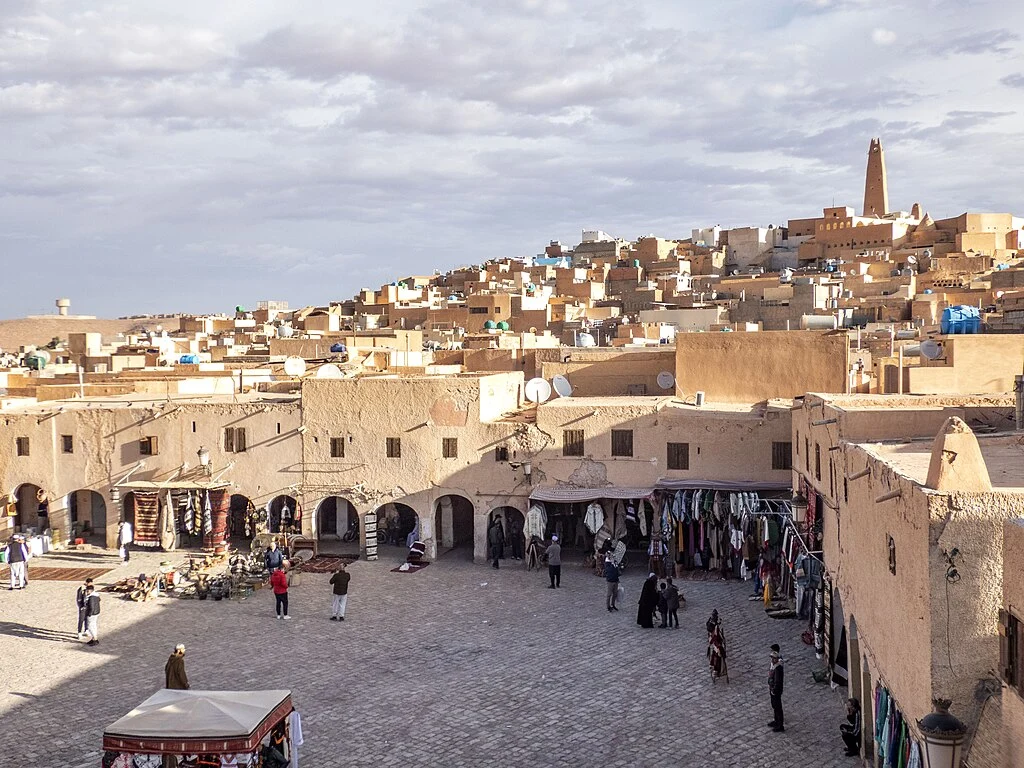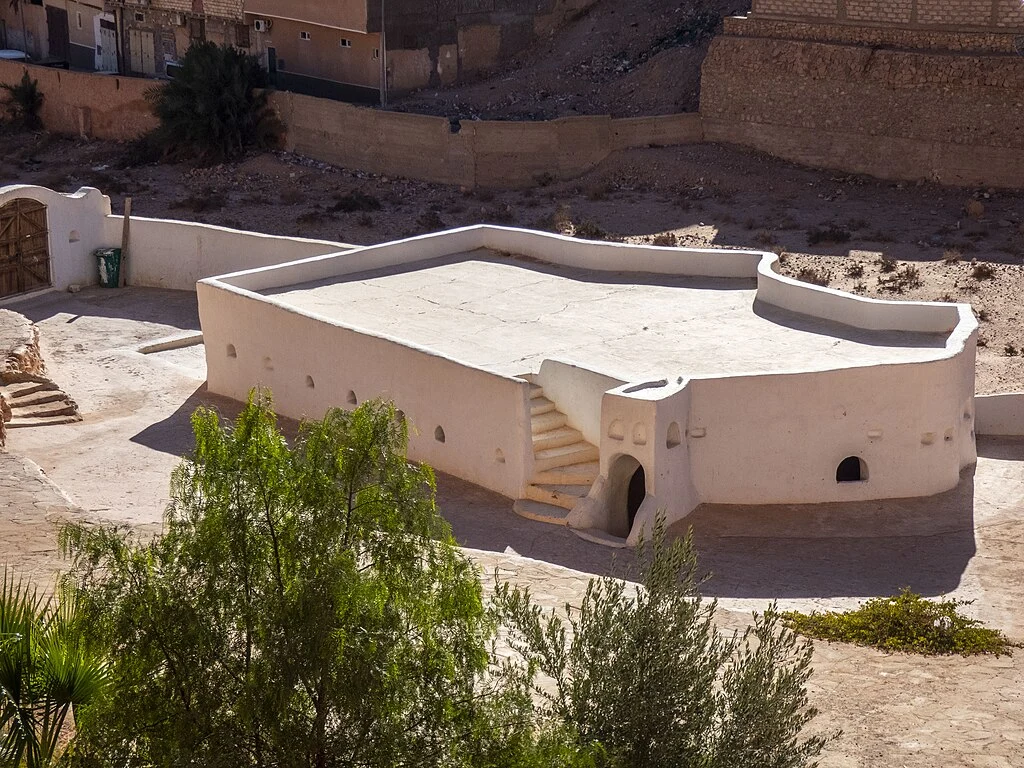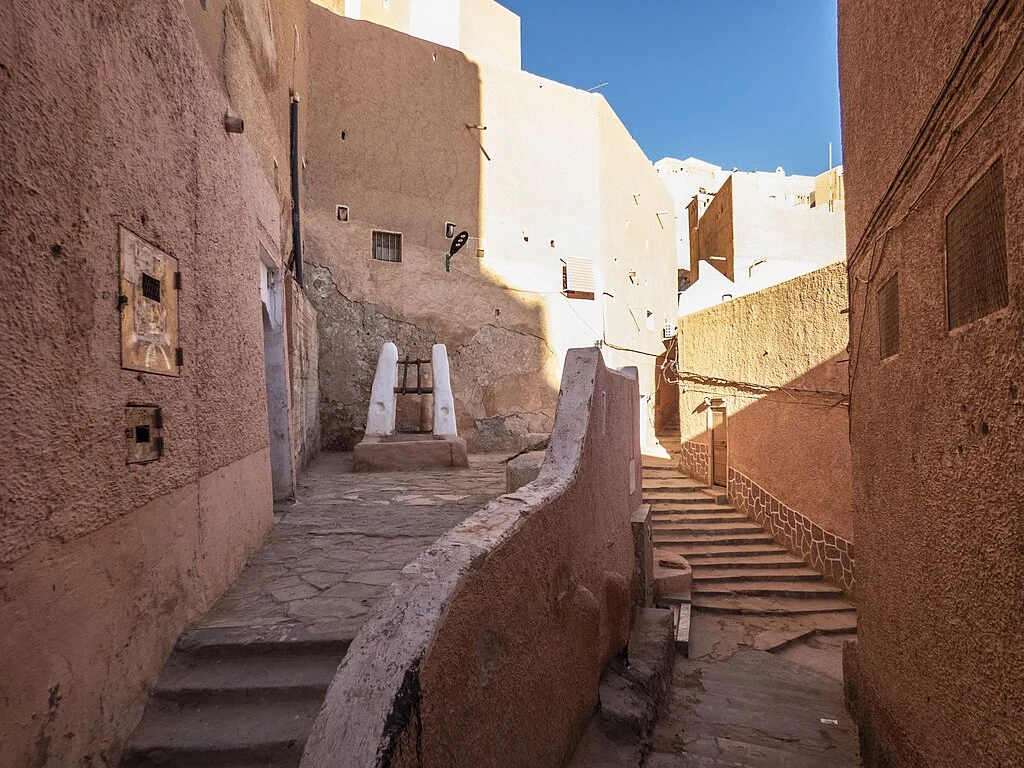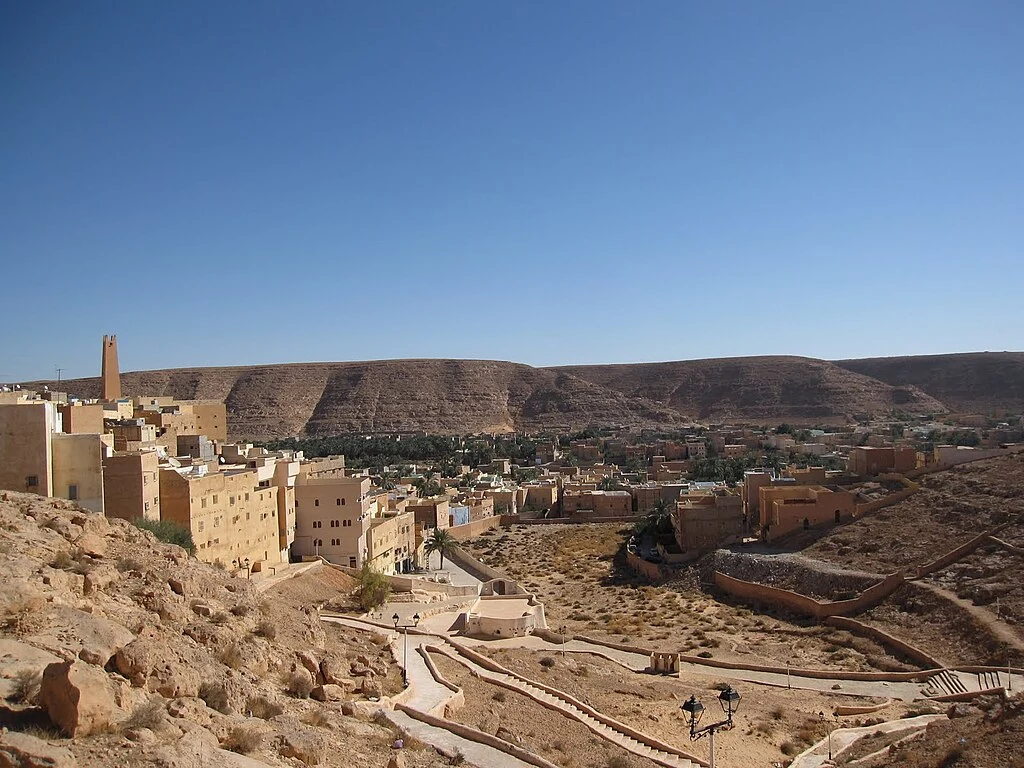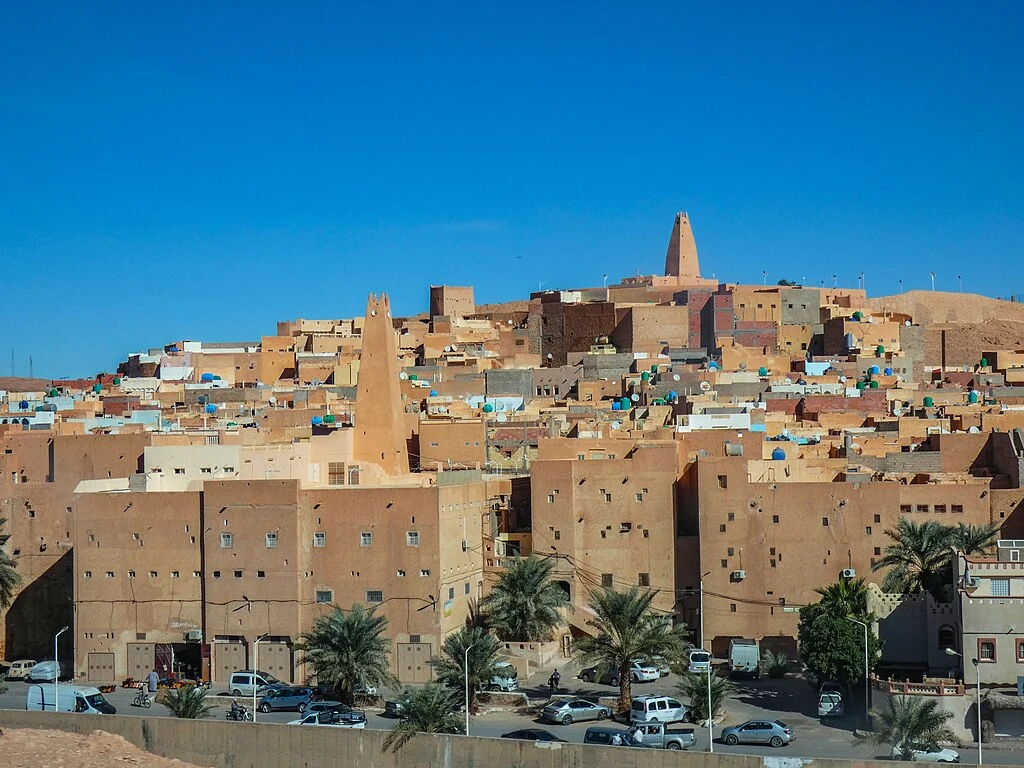The Mzab or M’zab (in Tamazight: ⴰⵖⵍⴰⵏ Aghlan or ⵉⵖⵣⵔ ⴰⵡⴰⵖⵍⴰⵏ Ighzer awaghlan – the Mzab Valley -, in Arabic: مزاب Mzab) is a Berber-speaking region in the northern Algerian Sahara, located in the wilaya of Ghardaia, 550 km south of Algiers (441 km as the crow flies). It covers about 8,000 square kilometers and is home to more than 200,000 inhabitants (2008 census).
The Mzab is a plateau traversed by a wadi of the same name. Its valley served as a refuge for the Ibadite Muslims who built five cities (pentapolis) there in the 11th century, then two more cities further north.
The Mzab Valley is part of the UNESCO World Heritage, it has a rich and original architectural heritage. Its main city is Ghardaïa, the capital of the homonymous wilaya.
Heritage
The region is home to five ksours, located on a rocky outcrop along the Mzab wadi and known as the Pentapolis. These are Ghardaïa, the main city, Beni Isguen, Melika, Bounoura, and El Atteuf. Adding the more recent cities of Berriane and El Guerrara.
The combination of a puritanical functioning of the Ibadite faith with the oasis lifestyle led to a strict organization of the territory. Each citadel was a sort of mosque-fortress, with the minaret serving as a watchtower. Standard-sized and -type houses were built in concentric circles around the mosque. The architecture of the Mozabite colonies was dedicated to equal communal life, with respect for family privacy. The constructions of the Mzab are of Berber style and have been replicated in other parts of the Sahara.
In summer, the Mozabites migrated to “summer citadels”, centered around palm tree oases. It is one of the major groups of oases in the Saharan desert, bordered by arid lands called chebka, crossed by dried riverbeds.
The Mzab Valley has been part of the World Heritage since 1982, as an intact example of traditional human habitat perfectly adapted to the environment:
“The landscape of the M’Zab Valley, created in the 10th century by the Ibadites around their five ksours, or fortified villages, seems to have remained intact. Simple, functional, and perfectly adapted to the environment, the architecture of the M’Zab was designed for communal living, while respecting family structures. It is a source of inspiration for today’s urban planners.”
— UNESCO
Among the protected areas:
Ghardaïa: old ksar; old mosque; current market square; old market square; underground mosque; water sharing; irrigation system.
Beni-Isguen: old ksar; Boulila tower; auction market.
Melika: old ksar; Cheikh Sidi Aïssa cemetery.
El Atteuf: old ksar; Cheikh Ammi Brahim mausoleum; market square.
Bounoura: old ksar; old ksar mosque; the front.
Outside the pentapolis, the ksars of El Guerrara and Berriane are classified as national heritage, the classification perimeter also includes the surrounding oases.
The Mzab or M’zab (in Tamazight: ⴰⵖⵍⴰⵏ Aghlan or ⵉⵖⵣⵔ ⴰⵡⴰⵖⵍⴰⵏ Ighzer awaghlan – the Mzab Valley -, in Arabic: مزاب Mzab) is a Berber-speaking region in the northern Algerian Sahara, located in the wilaya of Ghardaia, 550 km south of Algiers (441 km as the crow flies). It covers about 8,000 square kilometers and is home to more than 200,000 inhabitants (2008 census).
The Mzab is a plateau traversed by a wadi of the same name. Its valley served as a refuge for the Ibadite Muslims who built five cities (pentapolis) there in the 11th century, then two more cities further north.
The Mzab Valley is part of the UNESCO World Heritage, it has a rich and original architectural heritage. Its main city is Ghardaïa, the capital of the homonymous wilaya.
Heritage
The region is home to five ksours, located on a rocky outcrop along the Mzab wadi and known as the Pentapolis. These are Ghardaïa, the main city, Beni Isguen, Melika, Bounoura, and El Atteuf. Adding the more recent cities of Berriane and El Guerrara.
The combination of a puritanical functioning of the Ibadite faith with the oasis lifestyle led to a strict organization of the territory. Each citadel was a sort of mosque-fortress, with the minaret serving as a watchtower. Standard-sized and -type houses were built in concentric circles around the mosque. The architecture of the Mozabite colonies was dedicated to equal communal life, with respect for family privacy. The constructions of the Mzab are of Berber style and have been replicated in other parts of the Sahara.
In summer, the Mozabites migrated to “summer citadels”, centered around palm tree oases. It is one of the major groups of oases in the Saharan desert, bordered by arid lands called chebka, crossed by dried riverbeds.
The Mzab Valley has been part of the World Heritage since 1982, as an intact example of traditional human habitat perfectly adapted to the environment:
“The landscape of the M’Zab Valley, created in the 10th century by the Ibadites around their five ksours, or fortified villages, seems to have remained intact. Simple, functional, and perfectly adapted to the environment, the architecture of the M’Zab was designed for communal living, while respecting family structures. It is a source of inspiration for today’s urban planners.”
— UNESCO
Among the protected areas:
Ghardaïa: old ksar; old mosque; current market square; old market square; underground mosque; water sharing; irrigation system.
Beni-Isguen: old ksar; Boulila tower; auction market.
Melika: old ksar; Cheikh Sidi Aïssa cemetery.
El Atteuf: old ksar; Cheikh Ammi Brahim mausoleum; market square.
Bounoura: old ksar; old ksar mosque; the front.
Outside the pentapolis, the ksars of El Guerrara and Berriane are classified as national heritage, the classification perimeter also includes the surrounding oases.
